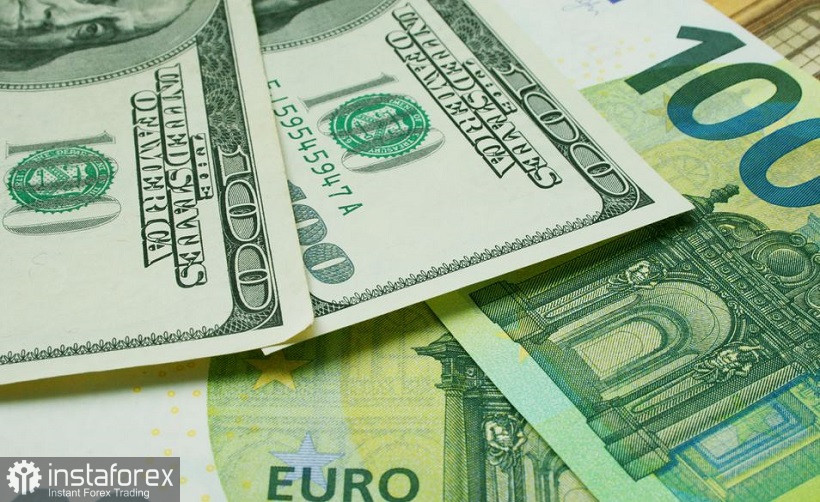The bears of the euro-dollar pair today made another attempt to break through the support level of 1.0860, which corresponds to the lower line of the Bollinger Bands indicator on the D1 timeframe. For the further development of the downward trend, sellers need to overcome this target, although the downward dynamics is now quite unstable and cautious. And yet the fact remains that bearish sentiment prevails in the pair, as evidenced by the April 300-point price decline. In recent days, traders have started to play at shorter distances, fixing profits in the middle of the 8th figure, that is, near the above-mentioned Bollinger Bands line. Therefore, the bears are not able (so far) to break through the support level in order to go to the area of the annual minimum, that is, to the level of 1.0805.
The fundamental background for the pair is in favor of further price reduction. On the dollar's side are geopolitics, the hawkish attitude of the Fed, key American macro indicators, and the yield of treasuries. All these factors strengthen the positions of dollar bulls, including in a pair with the euro, which continues to be under pressure.

In my opinion, in the medium term, EUR/USD bears will be able to break through the support level of 1.0860, opening the way to the bottom of the eighth figure. Recently, the pair has had too many "anchors" that do not allow buyers to organize a more or less large-scale counterattack. The last attempt, which was made last week (the price increase to the local high of 1.1185), ended in failure: on the same day, the bears seized the initiative and have been pulling the pair down since then, having already passed more than 300 points. The main index of personal consumption expenditures (the most monitored inflation indicator by the Federal Reserve) played the role of the trigger - it jumped to 5.4% year-on-year. This was followed by the nonfarm payrolls, which reflected a decrease in unemployment in the United States to 3.6% and an increase in the average hourly wage to 5.6 (y/y).
This week, the Fed's hawkish protocol was published, the text of which also inspired dollar bulls. The document states that many members of the Federal Reserve during the meeting expressed the opinion that raising the rate by 50 basis points at once at one or more upcoming meetings "would be justified."
The March meeting was held almost a month ago, but the hawkish mood among Fed members has only increased since then. This is evidenced by the rhetoric of many representatives of the Committee, who over the past two weeks have spoken in favor of a 50-point rate hike at the May meeting. And in general, many members of the American regulator are in favor of a more aggressive pace of tightening monetary policy this year. In particular, St. Louis Fed President James Bullard (who, by the way, has the right to vote in the Committee in 2022), said yesterday that the Central Bank's discount rate should be raised to 3.5%. In his opinion, only such rates will help to resist inflation. His colleagues – Chicago Fed President Charles Evans and Atlanta Fed President Raphael Bostic – indicated their intention to switch to neutral policy settings by the end of the year.
Such hawkish signals strengthened the U.S. currency, which followed Treasury yields. For example, the 10-year yield hit 2.680% today, the highest since February 2019.
The external fundamental background also contributes to the growth of the greenback. The protracted negotiation process between Russia and Ukraine and the absence of any optimistic messages from the negotiation field allow the safe dollar to feel quite comfortable in the main currency pairs. The sanctions confrontation between the EU, the U.S. and the Russian Federation, against the background of the impending energy crisis in the European region, only adds fuel to the fire, strengthening anti-risk sentiment.
Another geopolitical hotspot is Taiwan. After the United States began to strengthen arms supplies to the island and send American politicians there with official visits, relations between Beijing and Washington deteriorated again. China was particularly sensitive to information that U.S. House of Representatives Speaker Nancy Pelosi is planning to visit Taiwan. Beijing warned that the visit would seriously violate the one-China principle and the provisions of the three Sino-US joint communiques. Beijing stressed that Pelosi's visit "would cause serious damage to China's sovereignty and territorial integrity, and strike at the political foundation of bilateral relations."
Yesterday, there was information that the speaker of the lower house of Congress had contracted the coronavirus and, accordingly, will not be able to make the planned trip in the near future. But this fact does not negate the general problem that has formed on the China-Taiwan-US axis.
Thus, short positions on the EUR/USD pair are still in priority: it is advisable to use any more or less large-scale corrective upward pullbacks as an excuse to enter sales. The first target is located in the area of 1.0860–1.0850 (the lower line of the Bollinger Bands indicator on the D1 timeframe). If the bears overcome this price barrier, they will open their way to the base of the 8th figure, that is, to the level of 1.0805.





















